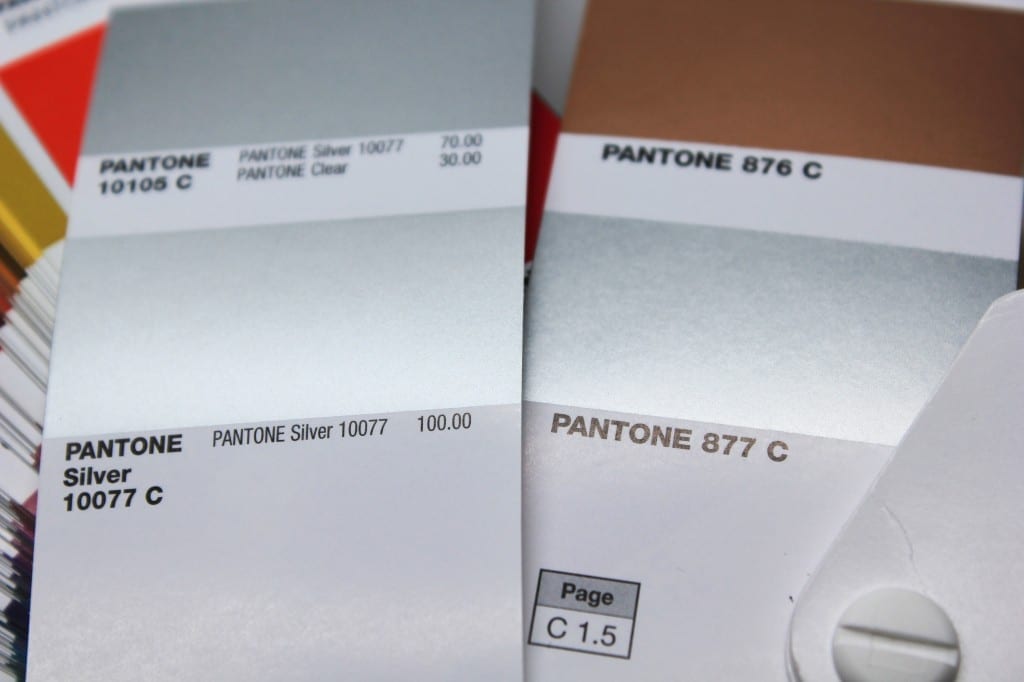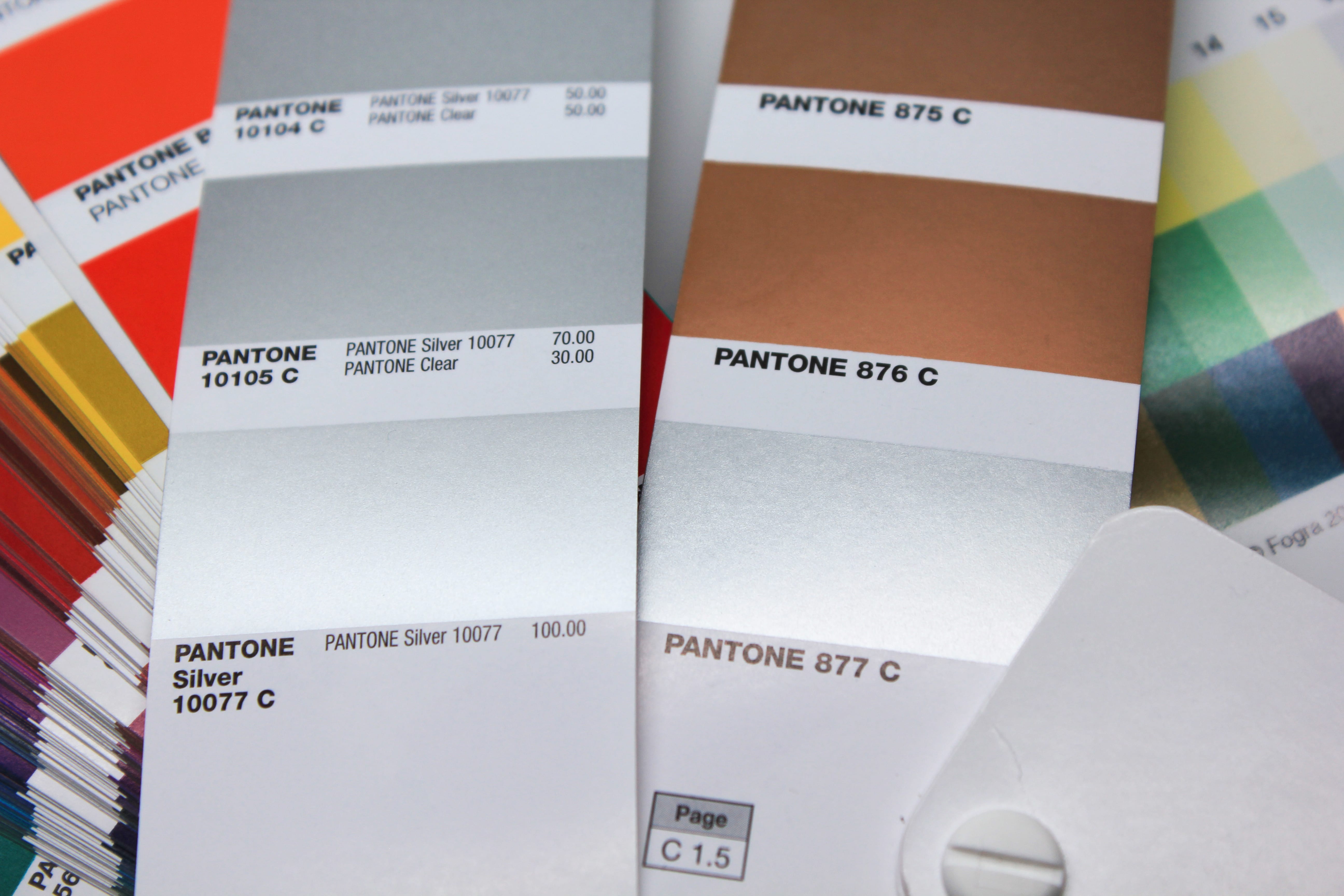Currently, PANTONE has two parallel Metallics colour fans:
- PANTONE Metallics Coated: Contains the classic metallic shades available since the late 1980s.
- Main basic colours: PANTONE 877, 876, 875 …
- Typical colour names: PANTONE 8020, 8040, 8060, etc.
- PANTONE Premium Metallics Coated: The new Metallics fan, which has been in existence since 2012, showing new, finer metallic shades.
- Main basic colour: PANTONE Silver 10077 C
- Typical colour names: PANTONE 10142, 10158, 10214, etc.
The main differences between the two fans lie in the composition of their respective basic colours: Firstly, there is the different Pantone Silver: PANTONE 877 or PANTONE Silver 10077 C. On the other hand, in the PANTONE Metallics Coated the silver is supplemented by further gold basic colours, while in the PANTONE Premium Metallics Coated the newly defined silver is the only metallic basic colour and is tinted by PANTONE Goe basic colours.
Pantone 877 and the gold inks contain metal flakes which, after the ink has dried on the paper, settle on the ink surface like leaves, creating a silver effect. This irregular surface structure can be very different and depends, among other things, on the drying time of the ink. As a result, the silver effect could vary from print to print. After varnishing, the silver effect was usually much weaker and less brilliant than before print finishing.
PANTONE Silver C(called PANTONE Silver 10077 C in the fan, but today mostly communicated by Pantone itself as PANTONE Silver C) consists of finely emulsified metal particles, which, in contrast to the metal flakes of the 877, are very evenly distributed on the paper due to the colour. The result is a more even, calm and brilliant silver surface that retains its shine and brilliance even after varnishing and is more stable in perspective than the previous colour. According to PANTONE, the durability of the ink has also been improved. The new silver is compatible with UV and water-based lacquers and can be laminated and foil embossed.
The Premium Metallics C colour fan from PANTONE shows colour reproduction with and without dispersion varnish. Important for printers: Due to the different composition, the manufacturer Eckhart recommends a different density: 1.0 for PANTONE 877 and only 0.7 for the new PANTONE Silver C, each measured with a polarized densitometer via the black filter.
One thing is not quite clear: The new 300 PANTONE Premium Metallics C colours are mixed from PANTONE Silver 10077 C and PANTONE Goe basic colours. However, GOE was discontinued in 2014. According to information from a Pantone employee, the colour shades will be converted to the 18 Pantone Matching System basic colours in a new fan generation – PANTONE Bright Orange (GOE) would then become PANTONE Orange 021 (PMS) as the basic colour. Since the basic colour is the same anyway, and has only differed in the thickness of the layer, this has no effect on the colourfulness.
Both PANTONE colour fans are stored as spot colours in our FIERY XF for the proof and can therefore be proofed as spot colours by Proof.de – in the context of the very poor proofability of metallic colours. As no metallic pigments are available for proofing, the silvery effect is only simulated by the velvety gloss of the proof paper. We use the EFI 4245 Gravure Proof Paper, which has a satin surface and allows a halfway decent silver simulation. However, a reasonable preview of the expected printing result is only possible in the PANTONE colour fan.
You can order PANTONE 877 or PANTONE Silver C Proofs here

In recent years, various problems have arisen with our previous proof paper supplier. On the one hand, we sometimes had to wait more than three months for paper deliveries; on the other hand, we sometimes had significant problems with batch-to-batch discrepancies, surface defects and much more. After lengthy deliberations, we decided in December to replace all the paper. We therefore received pallets of new paper at the turn of the year, which we are now gradually incorporating into our production. There will be no hard cut, but the new papers … read more

Digimarc is a digital watermark that can be used to embed information in images, videos or other media. Digimarc watermarks are invisible to the human eye, but remain recognisable to special software or devices. Digimarc is becoming increasingly popular in the packaging sector in particular, as this technology allows the digits of the EAN barcode and more to be applied invisibly to all areas of the packaging. Digimarc and EAN barcode at the supermarket checkout When scanning at the checkout, the checkout staff do not have to search for the … read more

From now on you can order proofs for metal decor printing on white sheet metal at proof.de: The ICC profile for Fogra60 is Metal-Printing_MPC1_FOGRA60.icc

Several errors have crept into the new PANTONE 2023 fan decks. In both the PANTONE Solid Coated and the Solid Uncoated color fans, there are colours for which the new ink formulations are incorrect. In the PANTONE Formula Guide Solid Coated fan 2023, PANTONE 107 C and PANTONE 108 C have absolutely identical ink recipes, as well as PANTONE 113 C and PANTONE 114 C. As the colors differ, this cannot be the correct. Several errors in the PANTONE Solid Uncoated fan 2023 In the PANTONE Solid Uncoated fan 2023 … read more

Whether it’s a large global corporation or a small company, the following often applies to designs or redesigns today: we develop everything for digital first.

In this short image video we – the Proof GmbH – introduce us and our work. Find out who we are and what drives us. What do you think of our short film?

Adobe products are ideal for image retouching and layout and handle RGB and CMYK colour profiles very well. However, when editing and retouching grayscale images, for example for a black-and-white photo book, the experience is quite different. Suddenly, images look completely different in InDesign than they do in Photoshop, and even when exporting the image to PDF, greyscale images are suddenly treated differently. This article explains where the problems lie with black-and-white images and greyscale profiles in InDesign and Photoshop layouts, and how you can work in a more ‘colour-accurate’ … read more

Over the last few months, we at Proof.de have been thinking about further improving our already very good colour measurement technology in terms of speed and measurement precision. Relatively quickly it became clear that only two devices would come into question: The KonicaMinolta MYIRO-9, the successor of the former FD-9, or the X-Rite ISIS 2 XL. The starting point: Since we at Proof GmbH have 5 proofing devices, the calibration of targets for profile optimisation is a time-critical undertaking for us. Therefore, we had been looking around for an upgrade of … read more

In recent weeks, there have been lengthy discussions on the Fogra digital printing mailing list as to whether a research project should be launched to define standardised tonal value gradations for spot colours. What is this all about? In the field of CMYK and seven-colour printing, the definition of clear, printable and proofable standards is well established and has been tried and tested in practice. If the paper or paper class is known and defined, a measuring standard such as M0/M1/M2 has been established and the content of optical brighteners … read more

Peter Jäger is an expert in colour management that reliably works across the boundaries of printers and monitors, web and print – essentially: cross-media.











